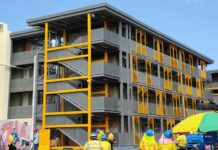Some professions are more hazardous than others, and construction is one of them; as such, it is subject to a number of regulations designed to safeguard workers. Adherence to the legislative regulations is paramount, not only for the safety of the staff but for the legality of the enterprise too. Obviously, ensuring safety in the workplace won’t always be easy or straightforward, but there are a few things that you can do to protect the endeavor; read on to find out more.
Compliance Explained
Compliance plays a large part in ensuring the safety of construction workers, and it refers to a set of enforceable rules and regulations imposed upon any number of industries. The rules obviously depend on the industry. For example, the regulations for construction workers will obviously be different to those working within the retail or hospitality sectors. The processes themselves have been developed, often through trial and error over decades, to ensure that they constitute the best practices.
Construction in all facets is subject to legislative procedures regardless of the size of the job itself. It doesn’t matter the scale of the work or the purpose of the job. In addition to ensuring the safety of the crew, it also takes into account the safety of those who will eventually live or work in the buildings. Obviously, compliance is important; it directly pertains to the safety of the workers. It helps to ensure that they are always using the right tools and methods for the job at hand in order to minimize risks. Failing to do so can be dangerous. Obviously, compliance does not totally remove all risk, but it is significantly reduced.
Encouraging Compliance with Safety Standards
In order to keep the crew safe on the construction site, you need to make sure that they are complying with the safety standards put in place, which is sometimes easier said than done. Obviously, you will need to ensure that all of those in management positions are leading by example, including yourself. Cutting corners to save time and money can be tempting, but it sets a bad precedent. The behaviors demonstrated by those in a position of power are emulated by the rest of the crew, which is why accountability and leading by example are important.
You will also need to think about how you can raise awareness of and import the value of workplace safety. In order for your crew to make the best choices in regard to their health and safety, they need to be aware of the risks. Risk assessments form one of the cornerstones of compliance; they highlight risks and the measures that need to be taken to minimize them. Demonstrations and training are also key in raising awareness.
Complying with safety standards is made infinitely easier by ensuring that your workers have access to the tools, materials and protective gear that they need to carry out the work safely. Safety gear should always be provided to workers, and it is paramount that you ensure that it is being worn properly. You also need to ensure that your workers have the tools that they need. Think about the tasks that they need to carry out. For example, installing or repairing an HVAC & R system requires the right parts, which can be found at McCombs Supply because it affects the air breathed by workers and inhabitants.
Understanding Your Liability
When it comes to ensuring that your worker’s health and safety are protected, there are levels of liability. Your liability will depend on the role that you fulfil on the construction site. There are some job roles that are geared towards ensuring the health and safety of the other workers. Those on the lowest level of responsibility legally bare very little liability unless they are willfully neglecting the safety protocols and procedures. In the end, the person who holds the most liability will be the foreman or the person in charge of the construction site.
It is their job to ensure that all workers are aware of the safety procedures in place and that they are following them. Although obviously, those processes and procedures will vary depending on the site and the job too. This is why risk assessments should be carried out before the work begins to ensure that the right safeguards have been put in place. Failing to do so does increase your liability and remove, and legal protection that you might have should your workers be injured or harmed as a result of your negligence.
In The End
Every business holds some liability for the health and safety of its staff, and this is why doing your best to ensure adherence and compliance to safety regulations on a building site is so important. Some people view the rules and procedures as an annoyance, an irritating procedure that wastes time and money, but they are in place for a reason. Having a keen awareness of the potential hazards that could befoul your workers is important.




























